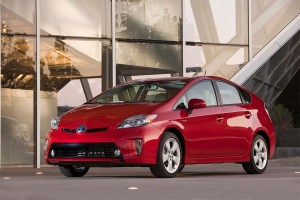It’s Earth Day, and if you’re thinking about something more environmentally friendly when it’s next time to trade in, you’re not alone. While sales of “green” cars are often linked to the rise and fall of fuel prices, there’s been a slow but unmistakable increase in demand, especially for hybrids and other battery vehicles which set an all-time record in 2012.
Products like the ever-popular Toyota Prius accounted for 3.1% of the overall U.S. new car market last year, reports data tracking service Experian Automotive, a 49% year-over-year jump from the 2.2% market share in 2011. The downside is that only about one in three hybrid owners buy another gas-electric model when they trade in, according to other industry reports.
“Hybrid vehicle owners have long been perceived as environmentally conscience consumers,” said Melinda Zabritski, Experian’s director of automotive credit. “While they may have made the vehicle purchase due to caring for the environment, our research shows that hybrid owners are economically minded as well. Hybrid owners tend to have outstanding credit histories, which also has enabled them to obtain financing at lower rates than typical consumers.”
According to Experian, the typical hybrid buyer’s loan came in at $25,807, compared to $26,691 for the average new auto loan last year. Hybrid buyers tended to take out shorter loans, at 61 months compared to 65 months for all U.S. new car buyers – and they scored an interest rate of just 3.51% compared to 4.36% for the average American auto buyer.
As for the 10 most popular hybrids – at least those financed rather than purchased outright:
| Top 10 financed new hybrid vehicles | Percentage share of hybrid market |
| 1. Toyota Prius | 37.2% |
| 2. Toyota Camry | 8.9% |
| 3. Toyota Prius V | 8.6% |
| 4. Toyota Prius C | 8.1% |
| 5. Chevrolet Volt | 6.3% |
| 6. Hyundai Sonata | 4.8% |
| 7. Lexus CT 200h | 4.2% |
| 8. Kia Optima | 2.7% |
| 9. Nissan Leaf | 2.7% |
| 10. Lexus RX 450h | 2.3% |
Hybrid sales have risen sharply in recent years, jumping from just 1.5% of the overall new car market as recently as 2006.
What’s significant about the 2012 Top 10 chart is the fact that it includes two advanced battery models for the first time, the fifth place Chevrolet Volt plug-in hybrid and the battery-electric Nissan Leaf, in ninth.
Analysts expect that demand for all forms of battery-based vehicles will continue to grow in the coming years, if for no other reason than the steady increase in available products. Most major manufacturers now offer several conventional hybrids and by the end of next year almost all plan to have plug-ins and pure battery-electric vehicles, or BEVs, in their showrooms, as well – though some may be limited to select markets, such as California.
That said, demand continues to lag proponents’ expectations. It appears all but certain that the Obama Administration’s goal of having 1 million plug-ins or BEVs on the road by the end of 2014 won’t happen.
Pricing and range limitations remain critical factors. But industry data also show that buyers aren’t necessarily thrilled with what they get. Only about 35% of conventional hybrid owners have been trading in for another battery-electric model.
One reason appears to be the ongoing gap between the mileage manufacturers claim and what buyers actually get in the real world. That has led the EPA – which oversees fuel economy testing – to revise its ratings process several times over the past decade. Further revisions are now under discussion.


The toxic battery production and disposal is anything but environmentally friendly. EVs simply are impractical for 99.9% of society and tax payers should not be forced to pay for this pipedream nightmare of Obama and the EPA, that has just begun but will last for decades after EVs are dead and buried.